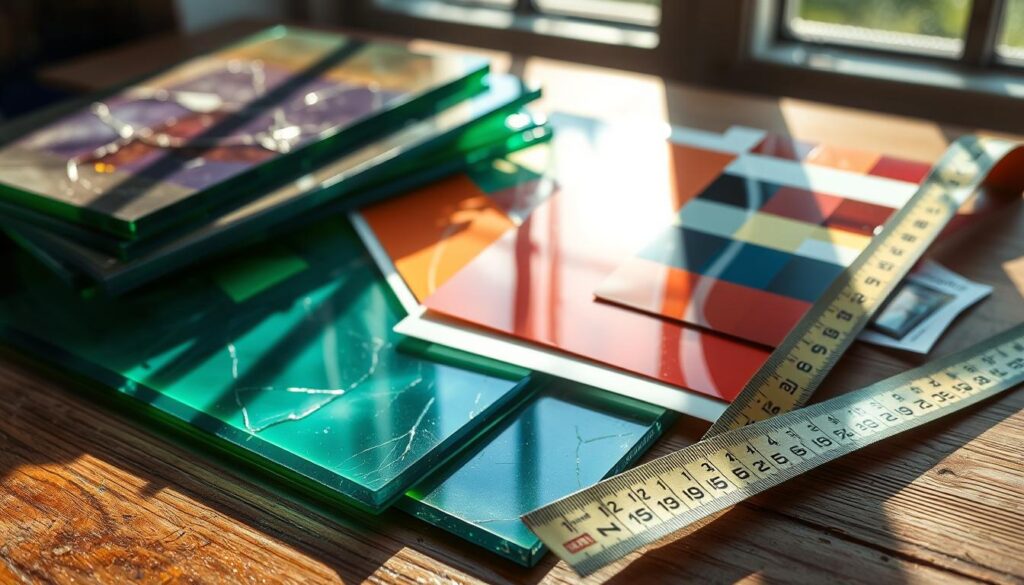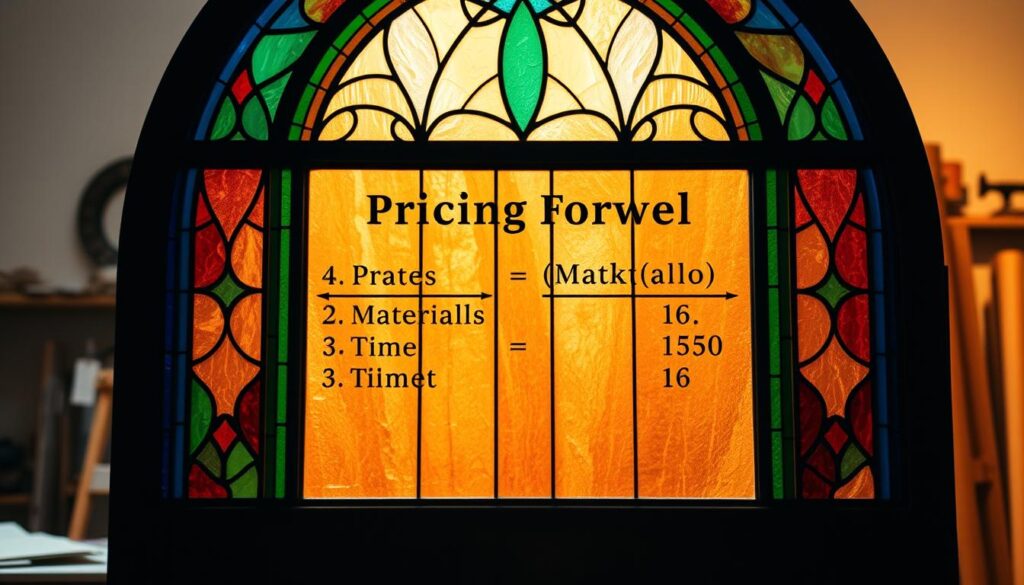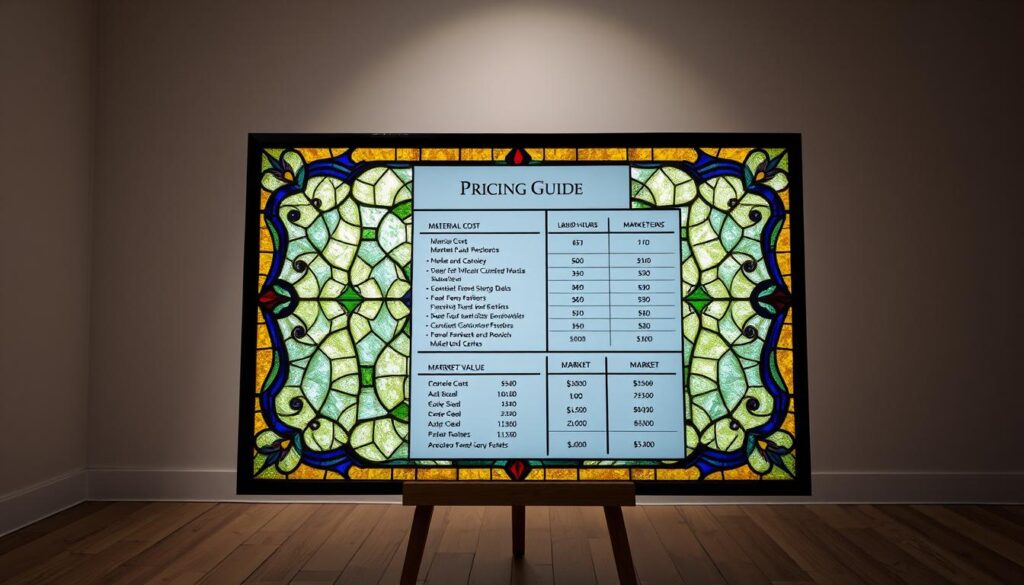Determining fair rates for custom glass art can feel overwhelming. Many creators rely on guesswork or social media polls, but these methods often lead to undervaluing your skills.
A structured approach ensures you cover expenses while earning a profit. This includes calculating material costs, labor hours, and design complexity. Without clear formulas, competing with mass-produced items becomes difficult.
This guide simplifies the process. You’ll learn objective strategies to price your pieces confidently. We’ll also explore how to stand out in a crowded marketplace.
Why Pricing Your Stained Glass Work Accurately Matters
Buyers associate higher prices with superior craftsmanship in decorative arts. A 2023 survey revealed 62% distrust pieces priced below market rates, viewing them as low-quality. This perception shapes whether collectors or bargain hunters engage with your art.
The Hidden Risks of Mispricing
Undervaluing your price work attracts one-time buyers, not loyal clients. Case studies show an $800 custom panel outsold a $25 import because clients linked premium prices to durability. Chronic underpricing also:
- Erodes studio profits over time
- Forces unsustainable production speeds
- Diminishes brand prestige
Pricing as a Reflection of Value
Skilled labor and material cost justify higher rates. Urban markets tolerate 20–30% premiums versus rural areas, but clear communication bridges gaps. For example:
- Explain unique techniques (e.g., hand-cut glass)
- Highlight longevity compared to factory-made items
- Share client testimonials about heirloom quality
Properly valued pieces see 40% higher repeat customer rates. Avoid discount traps—they devalue your work permanently.
Material Costs Breakdown
Every square foot of glass impacts your bottom line—measure wisely. Underestimating material cost leads to profit gaps, while overestimating scares buyers. Start with a simple formula: divide total expenses by project area.

Calculating Material Costs per Square Foot
Track every dollar spent on glass sheets, textures, and colors. For example:
- Panel 1: $100 ÷ 3.5 sq ft = $28.57/sq ft
- Panel 2: $85 ÷ 2.4 sq ft = $35.41/sq ft
The average cost per square foot in these samples is $31.83. Adjust for waste—add 15% if you’re new to cutting.
Including Consumables (Foil, Solder, Patina)
Copper foil costs rise with thicker glass. A 1/8″ piece uses 30% more foil than 1/16″. Compare solder types too:
- 60/40 solder: $12/lb (easier for beginners)
- Lead-free: $18/lb (preferred for kids’ rooms)
Patina adds $0.50 per fluid ounce. Factor in safety gear like gloves ($2/project).
Tracking Costs With Real-World Examples
One studio cut glass costs 18% by buying sheets in bulk. They also tracked blade replacements—$5 per 20 cuts. Use a spreadsheet to log every expense, even stained glass window photography for portfolios.
Example: A 4 sq ft panel with $125 materials and $20 consumables costs $36.25/sq ft. Revise estimates monthly as prices change.
Factoring in Labor and Time
Labor often outweighs material expenses in custom creations. Unlike bulk manufacturing, handmade pieces demand hours of precise work. Charging fairly ensures your studio thrives while honoring your craft’s value.
Setting a Fair Hourly or Square-Foot Rate
A $20/sq ft baseline works for standard panels. For complex designs, switch to hourly rates. Compare:
- 65-piece panel: 12 hours × $45/hour = $540
- Simple suncatcher: 2 sq ft × $20 = $40
Track actual time using a template. Rush orders? Add 25% for overtime labor cost.
Skill-Based Rate Adjustments
Apprentices might charge $25/hour, while masters justify $75. Consider:
- Years of experience
- Specialized techniques (e.g., 3D layering)
- Efficiency—seasoned artists often cut time by 30%
Include indirect costs like studio cleanup or client consultations. These hidden tasks add up.
Pricing Your Stained Glass Work: The Essential Formula
A transparent formula turns guesswork into confidence when valuing creative labor. By combining material expenses, skill, and business needs, you’ll set rates that sustain your studio.

Base Price Calculation: Materials + Labor
Start with hard costs. Add the price of glass, solder, and tools to hourly labor. For example:
- Materials: $31.83/sq ft (glass, foil, patina)
- Labor: $20/hour × 5 hours = $100
This creates a baseline of $131.83 before adjustments. Track every expense—even small items like blades.
Adding Complexity Costs
Intricate designs demand higher rates. Use multipliers based on number pieces or techniques:
- Simple panels: 1.0x base rate
- 3D layers: 1.5x–2x base rate
- Custom portraits: 2.5x + design fee
A 65-piece panel might add $97.50, lifting the total to $229.33.
Overhead and Profit Margin Percentages
Include indirect costs like studio rent (15%) and desired profit (25%). For the $229.33 example:
- Overhead: $34.40 (15%)
- Profit: $57.33 (25%)
Final price: $320.06. Adjust percentages for home studios or wholesale deals.
Adjusting for Design Complexity
Custom designs elevate your creations but demand precise pricing strategies. The number of cuts, layers, and techniques directly impacts your rates. A suncatcher with 10 pieces costs less than a 100-piece portrait—fairness lies in transparency.
Pricing Simple vs. Intricate Designs
Basic panels follow straightforward formulas. For example, charge $1–$3 per additional piece beyond a 20-piece baseline. A 50-piece floral design might add $90 to the base cost.
Use a complexity scoring system:
- Level 1: Single-layer designs (1.0x rate)
- Level 2: Bevel clusters (+15% per cluster)
- Level 3: Fused layers (2x material costs)
Handling 3D Pieces and Special Techniques
Dimensional art commands premiums. A 3D dragonfly panel could justify 2.5x the base rate due to:
- Structural engineering (e.g., armature support)
- Sandblasting depth charges ($10/hour)
- Collaborative artist royalties (10–20%)
Historic reproductions may include research fees, while paint applications bill at $25/hour. Always document time spent on unique processes.
Incorporating Overhead and Business Costs
Running a creative studio involves more than just material and labor expenses. Hidden costs like rent, utilities, and equipment maintenance can eat into profits if not accounted for. Smart calculations ensure your pricing covers all aspects of production.
Rent, Utilities, and Equipment Expenses
A $600 monthly studio space adds $20/day to your business costs. Break this down per project—if you complete 30 pieces monthly, that’s $20 per item. Seasonal utility spikes matter too:
- Summer AC costs: +$1.50/hour
- Winter heating: +$0.80/hour
- Kiln firings: $3.25 per use (electricity + wear)
Leasing tools? A $120/month grinder adds $4 per panel. Buying saves long-term but requires upfront cash. Track overhead supplies like gloves and blades—they add up fast.
Scaling Costs for Small vs. Large Studios
Home studios avoid rent but still need allocations. Dedicate 10% of earnings to:
- Insurance ($45/month)
- Website hosting ($12/month)
- Sales tax compliance ($5–$20 per sale)
Larger spaces benefit from bulk utility rates but face higher waste disposal fees. Always factor in emergency funds—3% of revenue prevents cash crunches.
Market Factors and Location Impact
Your studio’s zip code can dramatically influence what clients are willing to pay. A 40% price gap exists between New York City and the Midwest for similar stained glass art. This variance reflects local market dynamics, from disposable income to cultural appreciation for handmade work.
Urban vs. Rural Pricing Strategies
Metro areas tolerate premium prices due to higher costs and demand. For example:
- Gallery commissions: Urban spaces take 30–50%, requiring 20% higher base rates.
- Art fairs: Midwest booths average $500/day sales vs. $1,200 in coastal cities.
Rural business models thrive on volume. Offer smaller pieces like suncatchers at $75–$150 to match community budgets.
Communicating Value to Clients
Collectors pay more when they understand craftsmanship. Highlight:
- Technique: Hand-cut glass vs. factory prints.
- Longevity: Leaded panels last 80+ years.
- Exclusivity: Limited editions justify 15–30% markups.
Use case studies—show how a $2,500 custom piece became a family heirloom. This bridges market gaps by aligning art with emotional value.
Common Pricing Mistakes to Avoid
Many creators lose profits by repeating avoidable pricing errors. Whether you’re new or experienced, missteps can hurt your studio’s growth. Recognize these pitfalls early to protect your earnings.
Undervaluing Your Craft
73% of new artists undercharge in their first year. Emotional attachments or imposter syndrome often drive this. Compare these risks:
| Mistake | Impact | Fix |
|---|---|---|
| Family discounts | Loses $500+/year | Set firm minimums |
| Free revisions | Adds 3 unpaid hours | Charge $45/hour after first edit |
| Rushed deadlines | Doubles stress | Add 25% rush fees |
Scope creep is another trap. Clients may request “small changes” that eat hours. Define limits in contracts.
Ignoring Competitor Pricing Trends
Copying others’ prices blindly risks mismatching your cost structure. Instead, analyze their:
- Materials: Are they using cheaper glass?
- Labor: Do they outsource cutting?
- Audience: Are they targeting galleries or direct buyers?
Adjust for your unique value. If your stained glass features hand-painted details, charge 15–20% more than basic panels.
Track material shortages too. When copper foil prices spike, update rates monthly. Transparency builds trust.
Conclusion
Mastering the art of valuing handmade creations takes practice. Start with the core formula—material costs, labor, and overhead—then refine based on complexity and location. Your skills deserve fair compensation.
Revisit rates quarterly. Track trends in your business niche and adjust as needed. Confidence grows when numbers align with effort.
Explore advanced strategies like tiered pricing or wholesale discounts. Downloadable calculators simplify updates, saving hours of manual math.
Keep learning. Attend workshops, network with peers, and study market shifts. Every piece you create holds value—price it accordingly.
Ready to refine your approach? Share your experiences below or explore our resource list for deeper insights.
